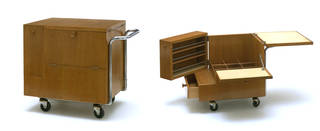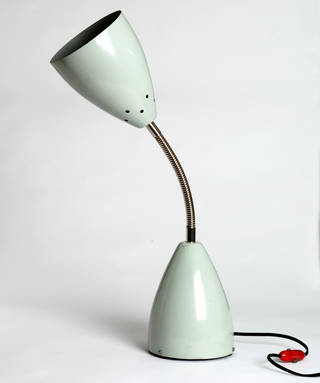The V&A's furniture collection contains an array of items once coveted by homeowners who were searching for timely, elegant and most importantly, Modern, design.
Penguin Donkey bookcase, 1939
In the late 1930s, the Penguin Donkey bookcase by Egon Riss was set to be a best seller, but its success was thwarted by the onset of war. Now it is a rare object.
It was made by Isokon, probably the most forward-thinking British furniture manufacturer of the 1930s. Its founder, Jack Pritchard, worked with the leading modernist designers and architects of the day to produce what have become design classics, such as Marcel Breuer's famous Long Chair.

Isokon furniture exploited the strength and lightness of bent plywood, and the Donkey is no exception. It was named the Donkey because of its organic, curvilinear shape with four legs and two 'panniers'. Books were stacked in the panniers while the space between them could be used for magazines and newspapers.
The Donkey impressed Allen Lane, the publisher of Penguin paperbacks. This new type of paperback book was the first reasonably priced, best-quality, international literature made available to a wide public – for the price of a pack of cigarettes. Lane inserted 100,000 leaflets for the bookcase into Penguin books, and the newly renamed Isokon Penguin Donkey looked set to be a great success. Unfortunately the Second World War broke out at exactly the time that the Donkey was launched, causing production to cease. Only about a hundred Donkeys were made.
The Penguin Donkey, however, has been reinvented several times. In 1963 Pritchard sold a new version ('Mark 2'), revised by the well-known designer Ernest Race, and in 2003 Isokon's successor firm, Isokon Plus, began making the Donkey 3, designed by Shin and Tomoko Azumi.
Drinks Trolley, 1938 – 9
The 1930s were a time of great change in society, art and design – nowhere more so than in central Europe. Modernism, inspired by the teachings of the Bauhaus design school, had become in vogue. Self-contained bar cabinets, or drinks trolleys, became a fashionable item of furniture because they were both functional and portable, and could be rearranged to suit open-plan living accommodations.
In about 1938, Eugene Schreiber, a timber merchant, and his wife, Elizabeth, commissioned a young designer, Zsuzsa Kozma, to re-design the living room of his family's flat in Budapest, Hungary. She was the daughter of an eminent Hungarian architect, designer and writer Lajoz Kozma and at this time, aged only 26, she worked in her father's office. The living room she designed for the Schreibers included a divan, chairs, a number of fitted units, and a drinks trolley. What was not built-in was easily moved, ensuring the room was open and flexible, in keeping with modernist principles.

The trolley has various folding and cantilevering elements, which contribute to its architectural and sculptural features. It was its portability, however, that saved it from potential ruin. Due to the political and social tumult in Hungary at the end of the Second World War, the Schreibers emigrated to England. Most of the built-in contents of the flat were abandoned but the drinks trolley came with them. Zsuzsa Kozma emigrated further, settling in Australia with her husband, where she anglicised her name to Susan Orlay and continued to design interiors.
Irradiation Lamp and Kitchen Clock, 1951 and 1956
After the Second World War, a new school devoted to the rebuilding of Germany was formed in Ulm. The school shifted its focus to experimental design and became the figurehead of Western German modernism, and was often referred to as a 'new Bauhaus'. Swiss artist, designer and architect Max Bill became its Director. Bill was a former Bauhaus student and one of the most significant figures in post-war industrial design.
The irradiation lamp and kitchen clock Bill designed were some of the earliest and most notable objects put into production. Everyday objects (kitchen appliances, audio visual equipment, tools, shelving etc) were a central focus for the work of Ulm designers, who promoted 'moral purpose through design' and 'good form'.

The lamp consists of two identical cones of metal sheeting, one to house the lamp and the other the adaptor, with a flexible 'goose-neck' tube connecting them, which would act as a carrying handle. The clock is moulded in an inverted, triangular 'V' shape and incorporates a mechanical timer. The Ulm school's achievements in industrial collaboration with companies such as Junghans (who manufactured the clock) and Braun produced an enduring legacy of modernist product design that was highly influential around Europe.

These examples of what was to be known as 'rational modernism' were unique and wholly unlike other post-war philosophies such as the more streamlined styling of American design. The strict tenets of Modernism, however, would soon be forced to adapt to a Cold War world, and enter a historic and radical phase of modern design.
Find out more about Modernism and domestic design


